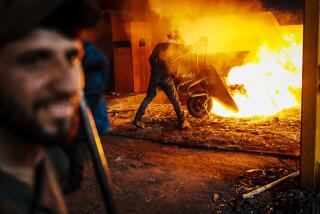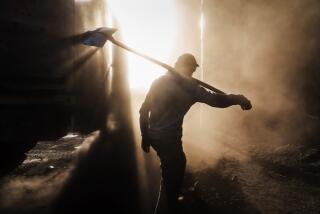Fall of City Could Sway the Doubters
- Share via
WASHINGTON — The capture of Mazar-i-Sharif by opposition forces can bring the U.S.-led military campaign in Afghanistan a variety of tactical benefits, but the greatest gain could be intangible: a new sense that America’s allies in this lengthening war will fight--and that they can score victories.
As U.S. forces have pounded Afghan targets for almost five weeks now, Pentagon officials have privately fretted that they did not have clear successes to show the world. They also worried that the fractious collection of tribal groups called the Northern Alliance might not be up to the task of a ground offensive.
If the capture of the strategic northern city proves to last--which is not certain--the campaign would at last have the kind of battlefield trophy likely to encourage coalition partners, dishearten the Taliban regime and give the allied military effort a momentum that could last the winter.
A victory in Mazar-i-Sharif “would be the first good news we’ve had,” said Ivo Daalder, a former National Security Council aide now at the Brookings Institution in Washington. It also “would quiet the greatest fear: that no matter what we did, nothing would happen on the ground.”
The U.S. strategy so far has been built around the notion of a partnership. While U.S. forces pounded away from the sky, the anti-Taliban fighters were to punch through government defensive positions to capture the key northern cities of Mazar-i-Sharif and Kabul, the Afghan capital.
One aim of this strategy was to compel Taliban forces to amass in a way that would make them more vulnerable to strikes by U.S. planes.
U.S. military planners also hoped that if the Northern Alliance began winning ground, it would frighten off some Taliban fighters--many of whom are not strongly committed to the cause. And they hoped that this momentum would spark an even more important development: an uprising by ethnic Pushtun tribes in the Taliban’s southern heartland.
Last month, the Northern Alliance’s first run at Mazar-i-Sharif fell short, amid squabbling among rival military commanders. And Pentagon officials have worried that many of these fighters seemed unwilling to risk a major charge.
Yet the Pentagon has badly wanted a victory before the snows of winter halt most ground fighting for months.
In the past week, the need for a victory has become even more urgent because of signs that public support in many nations, including some in Europe, was fading fast. Shifting world opinion had set off a search for a new approach in the White House and the Pentagon and had raised the issue of whether U.S. forces ought to begin taking steps to conduct the ground offensive themselves.
A lasting victory at Mazar-i-Sharif could put everything in a different light.
One U.S. military officer, who spoke on condition of anonymity, said the opposition fighters’ skill and fortitude are not yet fully clear. Even so, he said, he was impressed that alliance forces had moved quickly toward Mazar-i-Sharif in the last several days. He noted that some fighters had charged Taliban T-55 tanks--on horseback.
“It’s a good first step,” he said. “This is headway.”
A lasting victory at Mazar-i-Sharif would probably strengthen support for the war from wavering regimes in the Middle East. It also would give an important boost to America’s key alliance partner, Pakistani President Pervez Musharraf.
And it would encourage the Pentagon to stick with its original military plan, rather than move toward a buildup of forces for a more risky U.S.-led ground offensive, analysts said.
On a tactical level, the possession of Mazar-i-Sharif would offer a number of benefits.
It would permit a flow of crucial supplies to the Northern Alliance--from tanks and artillery to horse feed--from Uzbekistan and Tajikistan in the north. If the city’s air base proves functional and could be made secure, the U.S. forces could use it as a forward base.
That would cut hours off the flights that U.S. air crews make from bases and carriers hundreds of miles away in the Arabian Sea. The length of those flights has limited the number of sorties the United States has been able to mount.
With a forward base, U.S. forces would be able to bring in aircraft for damaging low-level attacks on Taliban ground forces--aircraft such as Apache helicopter gunships and A-10 Warthog ground attack planes. Pentagon officials have been signaling that they are considering using new planes for such tactics.
“It could be a vital advantage,” said Terrence Taylor of the London-based International Institute of Strategic Studies.
Yet the advances by the Northern Alliance have not cleared away all obstacles. And they might even have created some.
U.S. officials have been hesitant to allow the military campaign to progress too far because of their desire to have Afghan ethnic groups first agree on a framework for a successor government.
For almost three weeks, members of the Northern Alliance and the former monarch, Mohammad Zaher Shah, have been trying to meet in Ankara, the Turkish capital, to formally launch a Supreme Council of National Unity. The United States had hoped the council could then be installed in Mazar-i-Sharif to help create a model for post-Taliban Afghanistan.
But squabbles among anti-Taliban factions remain severe enough that no date has been set for the Ankara meeting.
“Unfortunately, there’s no great degree of unity on anything among this bunch except opposition to the Taliban. . . . We’re still basically at square one,” said a well-placed administration official.
*
Times staff writer Robin Wright contributed to this report.
More to Read
Sign up for Essential California
The most important California stories and recommendations in your inbox every morning.
You may occasionally receive promotional content from the Los Angeles Times.














